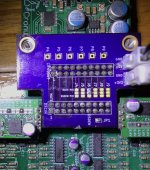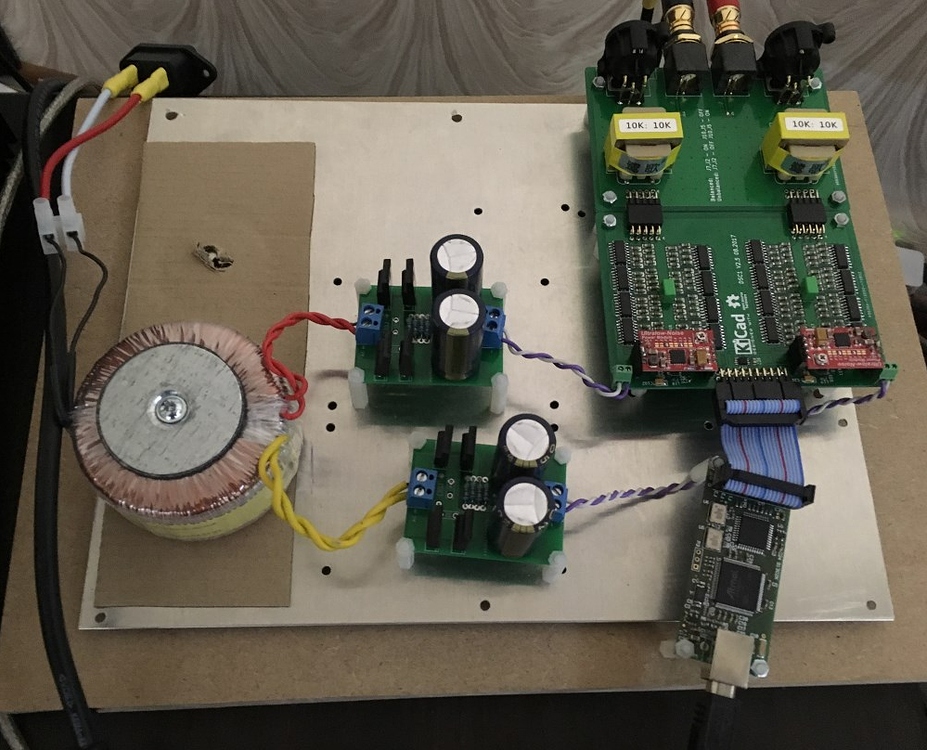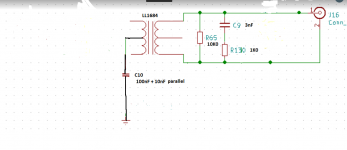I've been having a look at the TPA Hermes for BBB and I think that for the purposes of using a BBB to feed DSD to DSC2 we can use a much simpler arrangement that dispences with the Hermes and would be much more compact. I think the battery backup/shutdown can still be retained, which would be good for avoiding bricked BBBs.
I've started a new version of my isolator board that replaces the Amanero header with a BBB header with everything else staying the same. I now need to map the BBB header pins to the Cronus input header, via the isolator.
luchoh do you have a link/reference to which BBB header pins map to DSDL/DSDR/DSDclk/MCK-in/Mute/DSD-on?
nautibuoy, it is configurable via kernel driver parameters.
It is all described in miero’s documentation.
If you don’t have much time to read and understand it (can’t blame you, this is after all a hobby for most of us), pm me and we can teleconference and I can describe it quickly.
What I wonder is why would you want to replace Hermes? I think we still need an isolator. With a short PCB run you won’t be able to beat the price with parts and effort, plus TP’s documentation is sparse- all I know is combined from reading both the forums here and at TP (there is no official documentation).
Despite all that, it has been working rock solid for me and I feel it’s a good product.
Now, if you know something that would bring audible differences, then I’m all for it.
Don’t get me wrong: I’m all for helping even if you’d do it just for fun 🙂
Thanks luchoh. I have the pin mappings somewhere from my previous use of the BBB and NoDAC, but just couldn't lay my hands on the info yesterday as it was late and I was tired. I'll get back on it today.
I have a Hermes board but what I have in mind is very simple, doing nothing more than is absolutely required for the DSC2, and is much more compact than the long Hermes/Cronus chain of boards; my isolator board plugs into the BBB and DSC2 with Cronus piggy-backed on top. Cost will be comparable with TPA Hermes too (probably cheaper).
I have a Hermes board but what I have in mind is very simple, doing nothing more than is absolutely required for the DSC2, and is much more compact than the long Hermes/Cronus chain of boards; my isolator board plugs into the BBB and DSC2 with Cronus piggy-backed on top. Cost will be comparable with TPA Hermes too (probably cheaper).
nautibuoy, it is configurable via kernel driver parameters.
It is all described in miero’s documentation.
If you don’t have much time to read and understand it (can’t blame you, this is after all a hobby for most of us), pm me and we can teleconference and I can describe it quickly.
What I wonder is why would you want to replace Hermes? I think we still need an isolator. With a short PCB run you won’t be able to beat the price with parts and effort, plus TP’s documentation is sparse- all I know is combined from reading both the forums here and at TP (there is no official documentation).
Despite all that, it has been working rock solid for me and I feel it’s a good product.
Now, if you know something that would bring audible differences, then I’m all for it.
Don’t get me wrong: I’m all for helping even if you’d do it just for fun 🙂
Thanks luchoh. I have the pin mappings somewhere from my previous use of the BBB and NoDAC, but just couldn't lay my hands on the info yesterday as it was late and I was tired. I'll get back on it today.
I have a Hermes board but what I have in mind is very simple, doing nothing more than is absolutely required for the DSC2, and is much more compact than the long Hermes/Cronus chain of boards; my isolator board plugs into the BBB and DSC2 with Cronus piggy-backed on top. Cost will be comparable with TPA Hermes too (probably cheaper).
Oh, so if I understand correctly, you'll keep the Isolator/Reclocker capabilities by using Cronus/Rhea as is and using a new Isolator design which would make the physical arrangement more practical.
If I'm right, that would require certainly a lot of testing and perhaps some reverse-engineering and lots of reading of scattered information on the BBB/Hermes power cape implementation. Maybe Russ could help here, provided it's public domain information.
I think a more practical approach is to modify the adapter PCB between Cronus and DSC2.
What one can do is flip DSC2 so it is belly-up and rotate it 180 degrees so it is below BBB/Hermes/Cronus.
It may require however extending the RCA/XLR outputs with wires - I don't have it with me to measure the exact dimensions.
Thoughts?
Oh, so if I understand correctly, you'll keep the Isolator/Reclocker capabilities by using Cronus/Rhea as is and using a new Isolator design which would make the physical arrangement more practical.
If I'm right, that would require certainly a lot of testing and perhaps some reverse-engineering and lots of reading of scattered information on the BBB/Hermes power cape implementation. Maybe Russ could help here, provided it's public domain information.
I think a more practical approach is to modify the adapter PCB between Cronus and DSC2.
What one can do is flip DSC2 so it is belly-up and rotate it 180 degrees so it is below BBB/Hermes/Cronus.
It may require however extending the RCA/XLR outputs with wires - I don't have it with me to measure the exact dimensions.
Thoughts?
Luchoh, for our purposes of delivering DSD data and the associated flags to DSC2 Hermes is overcomplicated because it is fundamentally designed to interface TPA Buffalo DACs to BBB. We should look at the issue the same as we would connecting an Amanero, where we just need an isolator for the DSD data and another for the mute and DSD-on flags. We have no use for isolated I2C, indicator LEDS and multiplexors. That's why I will just substitute the BBB header for the Amanero one on the PCB I'm working on.
I will build and test my Amanero version first as soon as the PCBs arrive and if that is successful I'll order a BBB version and test that.
Regarding the connection to the V2.5.2, I've addressed that by flipping the DSC2 connector on my isolator board through 180 degrees so that the isolator/Cronus/Amanero (or BBB) sit off the front of the DSC2.
I'm already using a BBB/Botic combo as an HQP NAA, feeding data to my Buffalo3SE DAC via an Acko SO3 isolator/reclocker.
Thanks for the PM with the pin config information. I'll do a little on the PCB layout a bit later but first I need to eat and drink after a long day at work!
My revised (to suit V2.5.2) Amanero isolator boards have arrived. All being well I'll get the smd components assembled over the weekend.
I'm still waiting for my V2.5.2 board to arrive though; last seen leaving Russian customs...
I'm still waiting for my V2.5.2 board to arrive though; last seen leaving Russian customs...
Yes, I connect by this way. All capacitors are Wima FKP. I’m going to try 1uf + 0,1uf + 0,01uf and MKP capacitors in combination with FKP.
Thanks.
Yes, I connect by this way. All capacitors are Wima FKP. I’m going to try 1uf + 0,1uf + 0,01uf and MKP capacitors in combination with FKP.
Hi 🙂
can someone answer how and based on what, comes to R network values?
(these all of the same values R, at the output of logic chips...)
thanks 🙂
can someone answer how and based on what, comes to R network values?
(these all of the same values R, at the output of logic chips...)
thanks 🙂
I also ordered 6 of those at OSHPARK:
Cronus - DSC1/2 [Amanero] Header adapter
When I receive and test them and all works fine, I can send the excess to members here.
This is my first PCB project, so comments are more than welcome.

Received the PCBs today and hooked one up. Works like a charm.
I even feel it improved SQ. But that is in the subjectivity area.
Nevertheless- quite happy!
hello 🙂
Hi 🙂
can someone answer, how and based on what, comes to R network values?
(these all of the same values R, at the output of logic chips...)
thanks 🙂
View attachment 679474
Received the PCBs today and hooked one up. Works like a charm.
I even feel it improved SQ. But that is in the subjectivity area.
Nevertheless- quite happy!


Still waiting for Cronus + Rhea. Out of stock for now at twistedpearaudio.com
Hi mcluxun
Thanks
I am thinking about those summing R of 15K or 8K values mentioned in Your link page?
not about Rload.
Thanks
I am thinking about those summing R of 15K or 8K values mentioned in Your link page?
not about Rload.
Hi,
I am on going to build the DSC2 with pre-amp stage.
Someone could know where can i find the interconnexion between amanero and dsc2 like the picture below?

Thanx
I am on going to build the DSC2 with pre-amp stage.
Someone could know where can i find the interconnexion between amanero and dsc2 like the picture below?
Thanx
Last edited:
Hi,
I am on going to build the DSC2 with pre-amp stage.
Thanx
I am also thinking about a pre amp stage. What will you use for volume control and buffer?
I am thinking about using the volume controls (sigma 1 and lcduino) and possibly the line amp (alpha 24) by AMB audio.
If anyone has other suggestions for volume control/ buffer, please share here?
Last edited:
It's my first DSC 2.5 🙂Someone could know where can i find the interconnexion between amanero and dsc2 like the picture below?
The easiest way is to make this cable by yourself. You only need to buy 20Pin Ribbon Wire Flat Cable 1.27mm (any length you need) and 2 IDC2-20F connectors.
Remember, that is an I2S connection and is sensitive to cable length (especially considering the sample rate of DSD 256 or DSD 512) so you need to keep that ribbon cable as short as possible. Most folks say <10 cm max for decent performance.
If you need to cover any distance, it is better to do it on the USB side.
If you need to cover any distance, it is better to do it on the USB side.
- Home
- Source & Line
- Digital Line Level
- Signalyst DSC1
